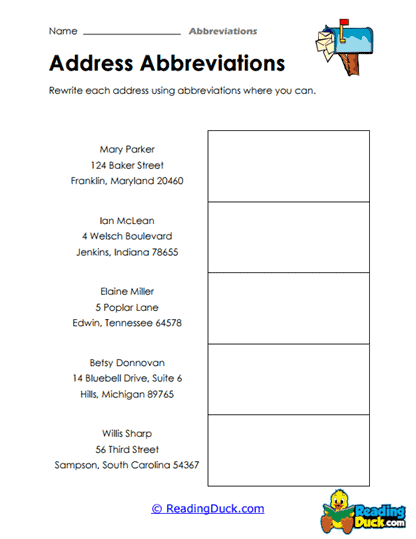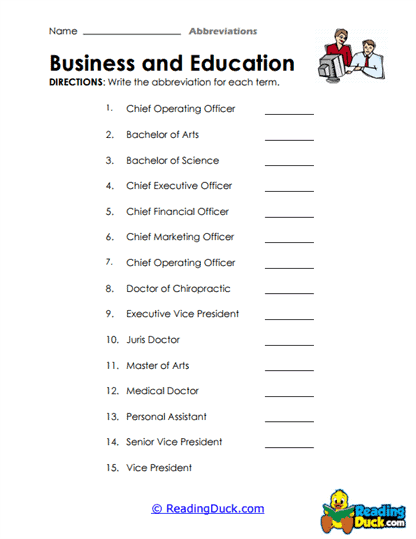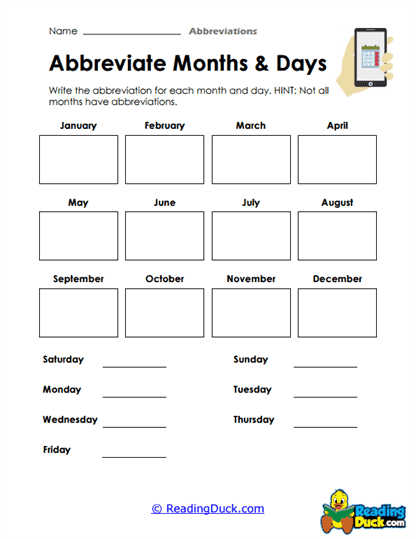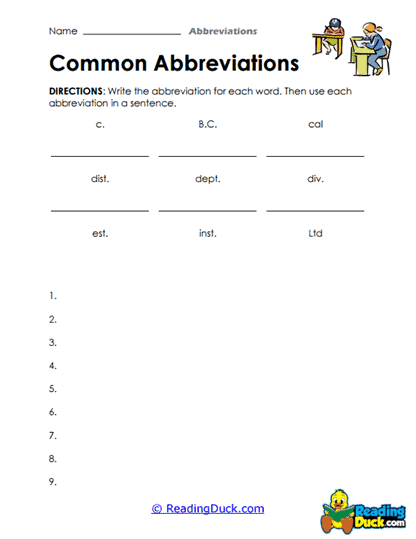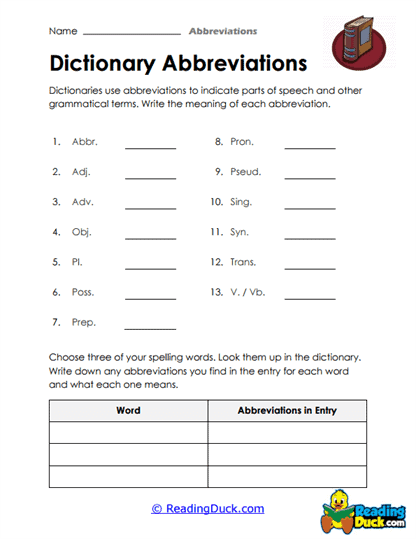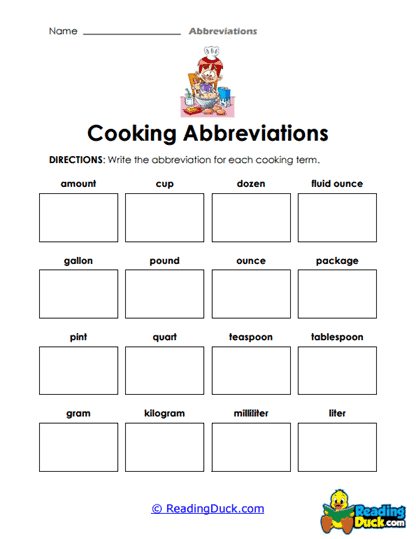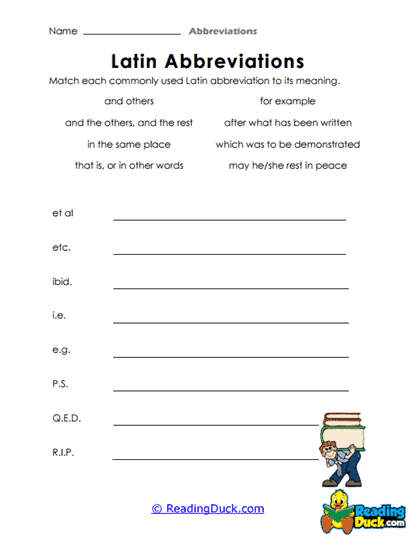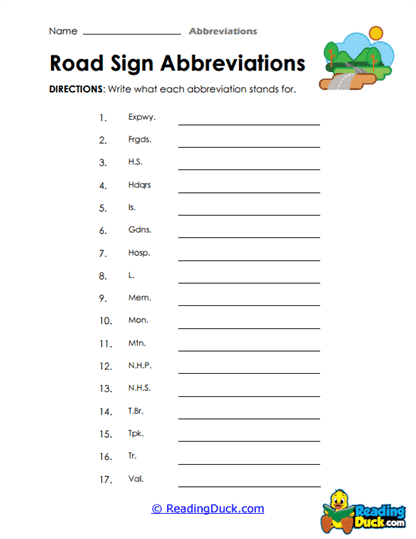Abbreviations Worksheets
About Our Abbreviation Worksheets
This collection of Abbreviations Worksheets is an essential component of the Language category under the Skills section. These worksheets provide a structured and accessible approach to learning abbreviations, which play a crucial role in the development of language and literacy skills. Through these worksheets, students can build a solid foundation in understanding how abbreviations function in both written and spoken language, allowing them to communicate more effectively and concisely.
The activities presented in the worksheets guide students through the learning process, enabling them to recognize, interpret, and apply abbreviations in various contexts. They serve as an excellent tool to foster not only reading comprehension but also written accuracy, helping learners grasp the importance of shortening words while maintaining clarity. This collection includes a wide range of exercises that are designed to cater to students at various levels of language proficiency, from elementary to more advanced learners.
All of the worksheets are provided in PDF format, ensuring easy access for both teachers and students. They can be easily viewed, downloaded, and printed for flexible use in both classroom and home learning environments. Additionally, each worksheet comes with a downloadable answer key, allowing for quick and efficient feedback during the learning process.
What Are Abbreviations?
Abbreviations are shortened forms of words or phrases. They are used to save time and space, allowing for more concise communication without sacrificing meaning. Abbreviations are common in everyday language, business correspondence, formal writing, and informal communication. Learning how to correctly use abbreviations is an important language skill that enhances both reading and writing efficiency.
Types of Abbreviations:
- Initialisms: These are abbreviations where each letter represents the first letter of a word, and each letter is pronounced individually.
- Example: "USA" stands for United States of America.
- Acronyms: Similar to initialisms, but the letters are pronounced as a single word rather than individually.
- Example: "NASA" stands for the National Aeronautics and Space Administration.
- Contractions: Words that are shortened by omitting certain letters and replacing them with an apostrophe.
- Example: "Can't" is a contraction of "cannot."
- Clippings: These are abbreviated forms of longer words, usually informal.
- Example: "Info" is a clipping of "information."
- Symbols and Shortened Forms: These are abbreviations used in technical and scientific writing, or in shorthand notations such as measurement or currency.
- Example: "$" stands for dollars, and "kg" stands for kilograms.
Different Usages of Abbreviations
Abbreviations serve various purposes across different contexts, enhancing clarity, efficiency, and ease of understanding. Here are some common uses:
- Formal and Informal Writing: In formal writing, abbreviations such as "Dr." for Doctor or "Prof." for Professor are widely used. In informal communication, abbreviations such as "OMG" (Oh My God) and "LOL" (Laugh Out Loud) are popular, especially in text messaging and social media.
- Scientific and Technical Writing: Abbreviations are vital in fields like science, technology, and engineering, where complex terms need to be simplified for quick reference. For example, "AI" stands for Artificial Intelligence, and "DNA" represents Deoxyribonucleic Acid.
- Time and Dates: Commonly used abbreviations in this category include "AM" for Ante Meridiem (before noon) and "PM" for Post Meridiem (after noon), as well as shortened forms for days of the week, such as "Mon" for Monday and "Wed" for Wednesday.
- Geographical Terms: Abbreviations for countries, cities, and other locations are frequently used. For instance, "UK" stands for the United Kingdom, and "NYC" stands for New York City.
- Common Everyday Uses: Abbreviations are frequently found in signage, labels, and directions. Examples include "Ave." for Avenue, "St." for Street, and "etc." for et cetera (and so on).
The Role of Abbreviations in Literacy Skills
Abbreviations play a significant role in enhancing students' overall literacy skills. By learning to identify and use abbreviations, students become more fluent in both reading and writing. They learn to process information more efficiently, allowing them to read and comprehend text quickly. Abbreviations also help students develop a keen awareness of language patterns, as they must understand the full form of words and phrases to recognize the abbreviated versions.
For writing, abbreviations encourage clarity and precision. Instead of writing out lengthy phrases or repeating common terms, students can use abbreviations to streamline their communication, making their writing more concise without losing meaning. This is particularly useful in professional and academic settings where brevity is valued.
In terms of speaking, abbreviations also help students become more effective communicators. Whether in casual conversations or formal presentations, the appropriate use of abbreviations allows speakers to maintain a smooth flow of ideas without becoming repetitive or verbose.
Engaging Activities to Reinforce Abbreviation Skills
To further solidify the concepts taught in the Abbreviation Worksheets, educators can incorporate a variety of activities to make learning more interactive and engaging. These activities can be adapted for both classroom and homeschool environments:
- Abbreviation Scavenger Hunt (Grades 3-6): In this activity, students are asked to search their surroundings for abbreviations. This could include signs, books, or product labels. After collecting examples, they present them to the class or in a group discussion.
- Abbreviation Match Game (Grades 2-4): Create a game where students match abbreviations to their full forms. For instance, students would match "USA" with "United States of America" or "Mrs." with "Mistress." This can be turned into a timed game to encourage quick thinking.
- Acronym Creation Challenge (Grades 5-8): Ask students to create their own acronyms from common phrases or names. For example, they could invent a new organization name and develop an acronym for it. This encourages creativity and helps students internalize the structure of acronyms.
- Role-Playing Abbreviations (Grades 2-5): Assign students roles such as Doctor, CEO, or Scientist, and have them write a short speech using abbreviations relevant to their role. This activity allows them to practice using abbreviations in a realistic and contextual way.
- Writing Prompts with Abbreviations (Grades 4-6): Give students writing prompts where they are encouraged to use as many abbreviations as possible without compromising the clarity of their writing. They can write letters, text messages, or diary entries, incorporating various abbreviations.
These activities engage students in critical thinking and encourage them to apply their understanding of abbreviations in both structured and creative ways.
Practical Importance of Learning Abbreviations
In today’s fast-paced world, the ability to use abbreviations effectively is a practical skill with numerous real-life applications. Students who master abbreviations become more competent in reading and writing, particularly when engaging with modern forms of communication such as emails, text messages, and social media platforms. In professional settings, abbreviations save time and allow for efficient communication, particularly in industries like healthcare, technology, and business, where specialized terms and jargon are common.
Moreover, abbreviations help students become better problem solvers. They learn to identify patterns in language and apply these patterns when encountering new or unfamiliar terms. This skill contributes to their ability to comprehend complex texts and adapt their communication style to various audiences.
In summary, learning abbreviations is more than just memorizing shortened words. It’s about mastering a key element of language that facilitates clearer and faster communication. These worksheets offer an effective means for students to practice and refine this skill, preparing them for real-world situations where abbreviations play a significant role in literacy and communication.
